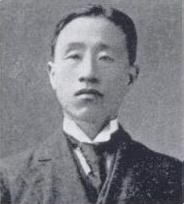Jang In-hwan
| Jang In-hwan | |
 Jang in a 1907 picture | |
| Korean name | |
|---|---|
| Hangul | 장인환 |
| Hanja | |
| Revised Romanization | Jang In-hwan |
| McCune–Reischauer | Chang In'hwan |
Jang In-hwan (born Pyongyang, 30 March 1875; died San Francisco, California, 24 April 1930) was a Korean independence activist. He is best known along with Jeon Myeong-un for his role in the 1908 assassination of Japan lobbyist and former American diplomat Durham Stevens.[1][2][dead link]
Incident
Jang, a Christian, emigrated from Korea to Hawaii in February 1905, and from there to the continental United States in August 1906.[1] He became involved with the Korean independence movement while living there, and joined the Daedong Bogukhoe. In March 1908, infuriated by Stevens' remarks about Japanese rule in Korea, the Daedong Bogukhoe held a joint meeting with the Dongnip Hyeophoe, another local association of Koreans of which Jeon was a member.[3] Yang Ju-eun, a fellow member of the association, recalled in a 1974 interview that Jang, in contrast to Jeon, did not say a single word during that meeting; Jang had a reputation as a "quiet and shy Christian gentleman." However, he purchased a gun from his roommate in order to circumvent laws which prevented Asians from owning guns.[4]
On March 23, 1908, Jeon and Jang approached Stevens at the Port of San Francisco as he prepared to embark on a ferry to Oakland to make a rail connection to Washington, D.C. Jeon fired his revolver at Stevens first, but missed, and instead rushed at him, using his weapon as a club to hit Stevens in the face. Jang then accidentally fired into the melee, striking Stevens twice in the back; Jeon was also shot in the confusion. The crowd which had gathered urged that they be lynched on the spot; Jang was arrested and held without bail on a charge of murder, while Jeon was sent to the hospital for treatment.[5] He received news of Stevens' death two days later with "manifest delight".[6]
Trial
Because there was insufficient evidence to prove that Jeon and Jang had conspired with each other, Jeon was released in June, and Jang ordered to stand trial as the sole defendant.[3] The Korean community hired three lawyers to defend Jang, among whom one, Nathan Coughlan, eventually agreed to take on the case pro bono. During the trial, he planned to use Arthur Schopenhauer's theory of "patriotic insanity" to argue that Jang was not guilty by reason of insanity.[4][5] Jang's trial was originally scheduled to begin on 27 July in the San Francisco Superior Court. However, on the day of the trial, presiding judge Carroll Cook held a conference in chambers with Coughlan and several members of the Korean community, as a result of which the trial was delayed by one month.[7][8] The jury found him guilty of second-degree murder on 23 December of that same year.[9] Jang himself stated through an interpreter that he would prefer death rather than imprisonment; however, he was ordered to serve a 25-year sentence at San Quentin State Prison, but was released in 1919, having served only 10 years.[4] He repatriated to Korea in 1927, where he attended the wedding of Cho Man-sik and established an orphanage in Sonchon, North Pyongan; however, under pressure from the Japanese government of Korea, he returned to the United States again.[1] He committed suicide in San Francisco in 1930, and was buried there.[5]
Jang was posthumously awarded the Order of Merit for National Foundation by South Korea's Ministry of Patriots' and Veterans' Affairs in 1962. In 1975, South Korean president Park Chung-hee ordered that he be reburied in the Seoul National Cemetery.[2]
References
- ^ a b c "미주한인 100년의 발자취 - 미국서 독립의거 - 전명운, 장인환 의사 (100 year footprints of Korean Americans - Brave deeds for independence - Jeon Myeong-un and Jang In-hwan, martyrs)". Voice of America. 2007-06-18. Retrieved 2007-09-27. [dead link]
- ^ a b "묘소편람: 장인환 (Grave browser: Jang In-hwan)". Ministry of Patriots' and Veterans' Affairs, Republic of Korea. Retrieved 2007-09-27.
- ^ a b Houchins, Lee (October 1994). "The Korean Experience in America, 1903-1924". In McClain, C. (ed.). Asian Indians, Filipinos, Other Asian Communities and the Law. Routledge. pp. 170–172. ISBN 0815318510.
{{cite conference}}: Unknown parameter|booktitle=ignored (|book-title=suggested) (help) - ^ a b c Lee, K.W.; Grace Kim (January 2005). "Yang, the Eyewitness: The patriot relates his account of the 1908 assassination of the infamous American mercenary Durham Stevens". KoreAm Magazine. Archived from the original on 2008-01-02. Retrieved 2007-11-10.
- ^ a b c Dudden, Alexis (2004). Japan's Colonization of Korea: Discourse and Power. University of Hawaii Press. pp. 81–83. ISBN 0-8248-2829-1. Some accounts, notably Yang's, state that Jeon only had a toy gun.
- ^ "Stevens is Dead; Japanese Mourn; American Diplomat Succumbs to Wounds Inflicted by Korean Fanatic". The New York Times. 1908-03-27. Retrieved 2007-09-27.
- ^ "To Try Korean Assassin; Chang, Who Killed Durham White Stevens, Will Plead To-day". The New York Times. 1908-07-27. Retrieved 2007-09-27.
- ^ "Trial of In Whan Chang postponed". Ogden Standard-Examiner. 1907-07-28. Retrieved 2007-11-11.
- ^ "Steven's Slayer Guilty; In Whan Chang, Korean, Is Convicted of Murder in Second Degree". The New York Times. 1908-12-25. Retrieved 2007-09-27.
Further reading
- Gim, Won-mo (January 1988). "장인환의 스트븐즈 사살사건 연구 (A Study of the Shooting of D.W. Stevens by Chang In-whan)". Dongyanghak. 18 (1): 273–310.
- 1880 births
- 1930 deaths
- Criminals who committed suicide
- Korean assassins
- Korean independence activists
- People from Pyongyang
- Prisoners and detainees of California
- Korean people imprisoned abroad
- Korean expatriates in the United States
- Suicides in California
- Recipients of the Order of Merit for National Foundation
